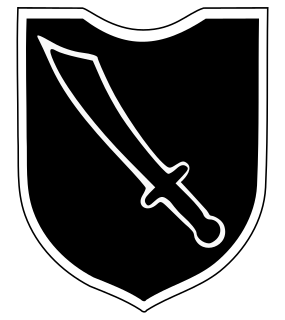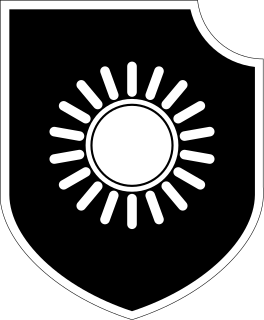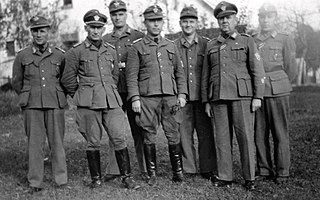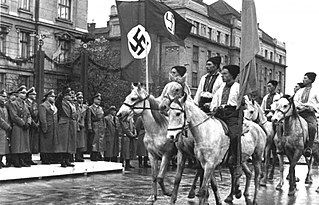 W
WThe 13th Waffen Mountain Division of the SS Handschar was a mountain infantry division of the Waffen-SS, an armed branch of the German Nazi Party that served alongside but was never formally part of the Wehrmacht during World War II. At the post-war Nuremberg trials, the Waffen-SS was declared to be a criminal organisation due to its major involvement in war crimes and crimes against humanity. From March to December 1944, the division fought a counter-insurgency campaign against communist-led Yugoslav Partisan resistance forces in the Independent State of Croatia, a fascist puppet state of Germany that encompassed almost all of modern-day Croatia, all of modern-day Bosnia and Herzegovina as well as parts of Serbia. It was given the title Handschar after a local fighting knife or sword carried by Ottoman policemen during the centuries that the region was part of the Ottoman Empire. It was the first non-Germanic Waffen-SS division, and its formation marked the expansion of the Waffen-SS into a multi-ethnic military force. Composed of Bosnian Muslims with some Catholic Croat soldiers and mostly German and Yugoslav Volksdeutsche officers and non-commissioned officers, it took an oath of allegiance to both Adolf Hitler and the Croatian leader Ante Pavelić.
 W
WThe 21st Waffen Mountain Division of the SS Skanderbeg was a German mountain infantry division of the Waffen-SS, the armed wing of the German Nazi Party that served alongside, but was never formally part of, the Wehrmacht during World War II. At the post-war Nuremberg trials, the Waffen-SS was declared to be a criminal organisation due to its major involvement in war crimes and crimes against humanity.
 W
WThe 23rd Waffen Mountain Division of the SS Kama was a German mountain infantry division of the Waffen-SS, the armed wing of the German Nazi Party that served alongside but was never formally part of the Wehrmacht during World War II. At the post-war Nuremberg trials, the Waffen-SS was declared to be a criminal organisation due to its major involvement in war crimes and crimes against humanity. The division was composed of German officers and Bosnian Muslim soldiers. Named Kama after a small dagger used by Balkan shepherds, it was one of the thirty-eight divisions fielded by the Waffen-SS during World War II. Formed on 19 June 1944, it was built around a cadre from the 13th Waffen Mountain Division of the SS Handschar but did not reach its full strength and never saw action as a formation.
 W
WThe 24th Waffen Mountain Division of the SS "Karstjäger" was a German mountain infantry division of the Waffen-SS, the armed wing of the German Nazi Party that served alongside, but was never formally part of, the Wehrmacht during World War II. At the post-war Nuremberg trials, the Waffen-SS was declared to be a criminal organisation due to its major involvement in war crimes and crimes against humanity. Named Karstjäger, the formation was one of the 38 divisions fielded by the Waffen-SS. Formed on 18 July 1944 from the SS Volunteer Karstwehr Battalion, its nominal strength was never more than theoretical and the division was soon reduced to the Waffen Mountain (Karstjäger) Brigade of the SS. Throughout its existence as a battalion, division and brigade, it was primarily involved in fighting partisans in the Karst Plateau on the frontiers of Yugoslavia, Italy, and Austria; the mountainous terrain required specialised mountain troops and equipment.
 W
WThe Balli Kombëtar, known as Balli, was an Albanian fascist, collaborationist and anti-communist movement during the Second World War. It was led by Ali Këlcyra and by Midhat Frashëri, who is often referred to as the father of Albanian nationalism. The movement was formed by members from the landowning elite, liberal nationalists opposed to communism and other sectors of society in Albania. The motto of the Balli Kombëtar was: "Shqipëria Shqiptarëve, Vdekje Tradhëtarëve". Eventually the Balli Kombëtar joined the Nazi established puppet government and fought as an ally against communist guerrilla groups.
 W
WDuring World War II, some Belarusians collaborated with the invading Axis powers. Until the beginning of Operation Barbarossa in 1941, the territory of Belarus was under control of the Soviet Union, as the Byelorussian Soviet Socialist Republic. However, memories of the Soviet repressions in Belarus and collectivization, as well as of the polonization and discrimination of Belarusians in the Second Polish Republic were still fresh, and many people in Belarus wanted an independent Belarus. Many Belarusians chose to cooperate with the invaders in order to achieve that goal, assuming that Nazi Germany might allow them to have their own independent state after the war ended.
 W
WThe Chetniks, formally the Chetnik Detachments of the Yugoslav Army, and also the Yugoslav Army in the Homeland and the Ravna Gora Movement, was a Yugoslav royalist and Serbian nationalist movement and guerrilla force in Axis-occupied Yugoslavia. Although it was not a homogeneous movement, it was led by Draža Mihailović. While it was anti-Axis in its long-term goals and engaged in marginal resistance activities for limited periods, it also engaged in tactical or selective collaboration with the occupying forces for almost all of the war. The Chetnik movement adopted a policy of collaboration with regard to the Axis, and engaged in cooperation to one degree or another by establishing modus vivendi or operating as "legalised" auxiliary forces under Axis control. Over a period of time, and in different parts of the country, the movement was progressively drawn into collaboration agreements: first with the puppet Government of National Salvation in the German-occupied territory of Serbia, then with the Italians in occupied Dalmatia and Montenegro, with some of the Ustaše forces in northern Bosnia, and, after the Italian capitulation in September 1943, with the Germans directly.
 W
WThe term Collaborationist Chinese Army refers to the military forces of the puppet governments founded by Imperial Japan in mainland China during the Second Sino-Japanese War and World War II. They include the armies of the Provisional (1937–1940), Reformed (1938–1940) and Reorganized National Governments of the Republic of China (1940–1945), which absorbed the former two regimes.
 W
WThe Wang Jingwei regime is the common name of the Reorganized National Government of the Republic of China, the government of the puppet state of the Empire of Japan in eastern China called simply the Republic of China. This should not be confused with the contemporaneously existing National Government of the Republic of China under Chiang Kai-shek, which was fighting with the Allies of World War II against Japan during this period. The country was ruled as a one-party republic under Wang Jingwei, a very high-ranking former Kuomintang (KMT) official. The region that it would administer was initially seized by Japan throughout the late 1930s with the beginning of the Second Sino-Japanese War.
 W
WA large numbers of Soviet citizens of various ethnicities collaborated with Nazi Germany during World War II. It is estimated that the number of Soviet collaborators with the Nazi German military was around 1 Million.
 W
WThe Courcelles massacre, sometimes known as the Rognac massacre, involved the killing of 27 civilians by a collaborationist militia associated with the Rexist Party in German-occupied Belgium during World War II. It occurred on 17–18 August 1944 near Courcelles, a suburb of the industrial city of Charleroi in Hainaut Province, shortly before the Liberation of Belgium in revenge for the killing of a Rexist official by the Belgian Resistance.
 W
WThe Croatian Home Guard was the land army part of the armed forces of the Independent State of Croatia which existed during World War II.
 W
WThe German-Croatian Police, also known as the German-Croatian SS Police and Gendarmerie, was a force established by the SS for internal security operations in the Independent State of Croatia, a puppet state of Nazi Germany during World War II. In all, 32,000 Croats served in the various units of this Police force, under German command, with the task of preserving order and help defend Axis strategic positions throughout the country.
 W
WLord Haw-Haw was a nickname applied to William Joyce, who broadcast Nazi propaganda to the UK from Germany during the Second World War. The broadcasts opened with "Germany calling, Germany calling", spoken in an affected upper-class English accent.
 W
WHorizontal collaboration referred to the romantic or sexual relationship many women in France really or allegedly had with members of the German occupation forces after the Fall of France in 1940. The existence of these liaisons had been a major reason for young men to join the French Resistance. After the Liberation of France from German occupation, such women were often punished for collaboration with the German occupiers.
 W
WLippmann, Rosenthal & Co. or Liro was a Dutch Jewish bank, located at the Nieuwe Spiegelstraat in Amsterdam. During the second World War, the Nazi government of Germany used the name of the bank for a separate branch, used for looting Jews, located at the Sarphatistraat.
 W
WDuring the German occupation of Luxembourg in World War II, some Luxembourgers collaborated with the country's Nazi occupiers. The term Gielemännchen was adopted by many Luxembourgers, first to describe German Nazis in general, and later for Luxembourg collaborators. The term came from the yellow uniforms of the Nazi Party. Their number, however, was limited.
 W
WOhrana were armed collaborationist detachments organized by the former Internal Macedonian Revolutionary Organization (IMRO) structures, composed of Bulgarians in Nazi-occupied Greek Macedonia during World War II and led by officers of the Bulgarian Army. Bulgaria was interested in acquiring Thessalonica and Western Macedonia, under Italian and German occupation and hoped to sway the allegiance of the 80,000 Slavs who lived there at the time. The appearance of Greek partisans in those areas persuaded the Axis to allow the formation of these collaborationst detachments. However, during late 1944, when the Axis appeared to be losing the war, many Slavophone Nazi collaborators, Ohrana members and VMRO regiment volunteers fled to the opposite camp by joining the newly founded communist SNOF. The organization managed to recruit initially 1,000 up to 3,000 armed men from the Slavophone community that lived in the western part of Greek Macedonia.
 W
WFollowing the German invasion of Poland in 1939, some Polish citizens of diverse ethnicities served in the Wehrmacht, in particular citizens from parts of Poland annexed by Germany such as Upper Silesia and Pomerania. Service in the German military was universal in nature in these areas, however, assessing the number of ethnic Poles involved is difficult due to the fluidity of national identity. At the low end, Polish estimates often place the number of native Poles at 250,000. Ryszard Kaczmarek's conservative estimate, based on documentary evidence, is 295,000; however, Kaczmarek considers this very low and is inclined to accept numbers of up to 500,000.
 W
WThe Polish Criminal Police was a non-uniformed, armed and secret formation of auxiliary police, colloquially called “Polish Kripo”, active in the years 1940-1945 in the General Government during the German occupation of Poland.
 W
WSchutzmannschaft Battalion 118 was a Schutzmannschaft auxiliary police battalion (Schuma). The core of the Schutzmannschaft battalion 118 consisted of Ukrainian nationalists from Bukovina in Western Ukraine. It was linked to the ultra-nationalist Organization of Ukrainian Nationalists, to its smaller Melnyk wing. 900 members of The OUN in Bukovina marched towards eastern Ukraine as members of paramilitary Bukovinian Battalion. After reinforcement by volunteers from Galicia and other parts of Ukraine, the Bukovinian Battalion had a total number of 1,500–1,700 soldiers. When the Bukovinian Battalion was dissolved, many of its members and officers were reorganized as Schutzmannschaft Battalions 115 and 118. Among the people incorporated into the Schutzmannschaft Battalions 115 and 118 were Ukrainian participants in the Babyn Yar massacre.
 W
WThe Serbian State Guard was a collaborationist paramilitary force used to impose law and order within the German occupied territory of Serbia during World War II. It was formed from two former Yugoslav gendarmerie regiments, was created with the approval of the German military authorities, and for a long period was controlled by the Higher SS and Police Leader in the occupied territory. It was also known as the Nedićevci after the leader of the German-installed Serbian puppet government, General Milan Nedić, who eventually gained control of its operations. It assisted the Germans in imposing one of the most brutal occupation regimes in occupied Europe and helped guard and execute prisoners at the Banjica concentration camp in Belgrade. Its leaders and much of the rank and file were sympathetic to the Chetnik movement of Draža Mihailović, and it was purged by the Germans on several occasions for that reason. In October 1944, as the Soviet Red Army closed on Belgrade, the SDS was transferred to Mihailović's control by a member of the fleeing Nedić administration, but it quickly disintegrated during its withdrawal west, with only a small number of former SDS members being captured by the British near the Italian-Yugoslav border in May 1945.
 W
WThe Slovene Home Guard was a Slovene anti-Partisan military organization that was active during the 1943–1945 German occupation of the formerly Italian-occupied Province of Ljubljana. It consisted of former Village Sentries, part of Italian-sponsored Anti-Communist Volunteer Militia, re-organized under Nazi command after the Italian Armistice.
 W
WThe Slovenian National Defense Corps was an anti-Slovene Partisans military organization that was active in the territory of the Operation Zone of the Adriatic Littoral in the German-occupied portion of Italy. Although led by Anton Kokalj, it was directly subordinated to German Nazi commander Odilo Globočnik. The organization was ideologically and organizationally linked to the Slovene Home Guard that was active in Province of Ljubljana.
 W
WStatspolitiet was from 1941 to 1945 a National Socialist armed police force that consisted of Norwegian officials after Nazi German pattern. It operated independently of the ordinary Norwegian police. The force was established on 1 June 1941 during the German occupation of Norway. The initiative for the force came from the later chief Karl Marthinsen and other prominent members of the collaborationist party Nasjonal Samling. At its peak, in 1944 there were 350 employees in Statspolitiet, in addition to a larger number who collaborated or rendered services for them. Its purpose was primarily to combat so-called political crimes, refugees, espionage, sabotage, armed resistance and other kinds of resistance against the German occupation forces or the Norwegian collaborationist Quisling regime. Statspolitiet played an important role during the Holocaust in Norway, aiding in the deportation of the Jews in Norway. Norwegians were arrested by contemporary laws, and many were later sent to prison camps in Norway and concentration camps in what was then Germany. Statspolitiet was organized with a headquarters in Oslo and six subsidiaries in Oslo and Aker, Stavanger, Bergen, Trondheim, Tromsø and Kirkenes. Statspolitiet was subordinate to the chief of the security police and the Norwegian Minister of Police, Jonas Lie. Statspolitiet also received orders directly from the Reich Security Main Office. The general of Statspolitiet, Karl A Marthinsen was assassinated by the Norwegian resistance movement on 8 February 1945. This caused massive reprisals, in which 34 imprisoned resistance fighters were executed at Akershus Fortress.
 W
WCollaboration with Nazi Germany in German-occupied Ukraine took place during the occupation of what is now Ukraine by Nazi Germany in World War II. The new territorial divisions included District of Galicia and Reichskommissariat Ukraine, which covered both the south-eastern territories of the Second Polish Republic and the Ukrainian Soviet Socialist Republic, across the former borders.
 W
W"Why Have I Taken Up the Struggle Against Bolshevism" is a two-page open letter by the Russian lieutenant general and the commander of the Russian Liberation Army Andrey Vlasov. After the twenty-three years' service in the Soviet military, Vlasov changed the allegiance during World War II to collaborate with Nazi Germany. According to Robert Service, Vlasov was outraged when Joseph Stalin denied him permission to retreat in time from an unavoidable encirclement of the 2nd Shock Army. In June 1942 Vlasov refused to be airlifted for evacuation to the rear and chose to stay with his men. Having been captured by the Germans in the same month, Vlasov published his open letter in the newspaper Zarya on March 3, 1943. For his speeches about future independent Russia Vlasov was placed by Germans under house arrest.